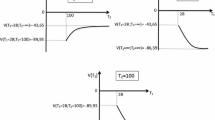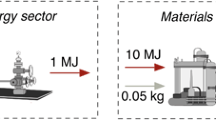Abstract
We study the welfare-theoretic consequences of diverging social and private time-preference rates and time-to-build for the transition to a low-carbon energy industry. We show that time-to-build, a prevalent characteristic of capital accumulation in the energy sector, amplifies the distortion induced by the split discount rates. Thus, these two characteristics create in a mutually reinforcing way less favorable circumstances for the introduction of new clean energy technologies as compared to the social optimum, even if welfare losses from emissions are internalized. We discuss resulting policy implications with particular emphasis on the energy sector.
Similar content being viewed by others
References
Arrow KJ, Kurz M (1970) Public investment, the rate of return, and optimal fiscal policy. John Hopkins, Baltimore
Arrow KJ, Lind RC (1970) Uncertainty and the evaluation of public investment decisions. Am Econ Rev 60(3): 364–378
Asea PK, Zak PJ (1999) Time-to-build and cycles. J Econ Dyn Control 23(8): 1155–1175
Bambi M (2008) Endogenous growth and time-to-build: the AK case. J Econ Dyn Control 32(4): 1015–1040
Bellman R, Cooke KL (1963) Differential-difference equations. Academic Press, New York
Blanchard OJ (1985) Debt, deficits, and finite horizons. J Polit Econ 93(2): 223–247
Boucekkine R, Licandro O, Puch LA, del Rio F (2005) Vintage capital and the dynamics of the AK model. J Econ Theory 120(1): 39–72
Bovenberg AL, Smulders S (1995) Environmental quality and pollution-augmenting technological change in a two-sector endogenous growth model. J Public Econ 57(3): 369–391
Calvo GA, Obstfeld M (1988) Optimal time-consistent fiscal policy with finite lifetimes. Econometrica 56(2): 411–432
DeMarzo P, Fishman M, He Z, Wang N (2009) Dynamic agency and the q theory of investment. Mimeo
Drèze J, Stern N (1990) Policy reform, shadow prices, and market prices. J Public Econ 42(1): 1–45
El-Hodiri MA, Loehman E, Whinston A (1972) An optimal growth model with time lags. Econometrica 40(6): 1137–1146
Fabbri G, Gozzi F (2008) Solving optimal growth models with vintage capital: the dynamic programming approach. J Econ Theory 143(1): 331–373
Frederick S, Loewenstein G, O’Donoghue T (2002) Time discounting and time preference: a critical review. J Econ Lit 40(2): 351–401
Gandolfo G (1996) Economic dynamics, third, completely revised and enlarged edition. Springer, Berlin
Van der Gerlagh R, Zwaan B (2003) Gross world product and consumption in a global warming model with endogenous technological change. Resour Energy Econ 25(1): 35–57
Gollier C (2002) Discounting an uncertain future. J Public Econ 85(2): 149–166
Gollier C (2010) Pricing the future: the economics of discounting and sustainable development. Unpublished manuscript, Princeton University Press, Princeton (to appear)
Goulder LH, Mathai K (2000) Optimal CO2 abatement in the presence of induced technological change. J Environ Econ Manage 39(1): 1–38
Goulder LH, Schneider SH (1999) Induced technological change and the attractiveness of CO2 abatement policies. Resour Energy Econ 21(3–4): 211–253
Groom B, Hepburn C, Koundouri P, Pearce D (2005) Declining discount rates: the long and the short of it. Environ Resour Econ 32(1): 445–493
Hale J (1977) Theory of functional differential equations. Springer, New York
Heinzel C (2008) Implications of diverging social and private discount rates for investments in new generation technology. A New Case for Nuclear Power? Paper presented at the annual meeting of the Verein für Socialpolitik in Graz, Austria
Jaffe AB, Newell RG, Stavins RN (2005) A tale of two market failures: technology and environmental policy. Ecol Econ 54(2–3): 164–174
Kamien MI, Schwartz NL (1992) Dynamic optimization. The calculus of variations and optimal control in economics and management. 2nd edn. Elsevier, Amsterdam
Kolmanovskii VB, Myshkis AD (1999) Introduction to the theory and applications of functional differential equations. Kluwer, Dordrecht
Mehra R, Prescott EC (2003) The equity premium in retrospect. In: Constantinides GM, Harris M, Stulz R (eds) Handbook of the economics of finance. Elsevier B.V, Amsterdam, pp 887–936
Newell RG, Jaffe AB, Stavins RN (1999) The induced innovation hypothesis and energy-saving technological change. Q J Econ 114(3): 941–975
Nordhaus WD (2002) Modeling induced innovation in climate-change policy. In: Grübler A, Nakicenovic N, Nordhaus WD (eds) Technological change and the environment. Resources for the Future, Washington, DC, pp 182–209
Portney, PR, Weyant, JP (eds) (1999) Discounting and intergenerational equity. Resources for the Future, Washington, DC
Stiglitz JE (1982) The Discount Rate for Benefit-Cost Analysis and the Theory of the Second Best. In: Lind RC, Arrow KJ, Corey GR, Dasgupta P, Sen AK, Stauffer T, Stiglitz JE, Stockfisch JA, Wilson R (eds) Discounting for time and risk in energy policy. John Hopkins University Press, Baltimore, pp 151–204
Tahvonen O, Salo S (2001) Economic growth and transition between renewable and nonrenewable energy resources. Eur Econ Rev 45(8): 1379–1398
Tirole J (1981) Taux d’Actualisation et optimum second (discount rate and second-best optimum). Rev Econ 32(5): 829–869
Van der Zwaan BCC, Gerlagh R, Klaassen G, Schrattenholzer L (2002) Endogenous technological change in climate change modelling. Energy Econ 24(1): 1–19
Winkler R (2005) Structural change with joint production of consumption and environmental pollution: a neo-Austrian approach. Struct Change Econ Dyn 16(1): 111–135
Winkler R (2008) Optimal compliance with emission constraints: dynamic characteristics and the choice of technique. Environ Resour Econ 39(4): 411–432
Winkler R, Brand-Pollmann U, Moslener U, Schlöder J (2005) On the transition from instantaneous to time-lagged capital accumulation. The case of Leontief-type production functions. Discussion-Paper No. 05-30. Centre for European Economic Research (ZEW), Mannheim
Yaari ME (1965) Uncertain lifetime, life insurance, and the theory of the consumer. Rev Econ Stud 32(2): 137–150
Author information
Authors and Affiliations
Corresponding author
Additional information
We are grateful for valuable comments to Stefan Baumgärtner, Johannes Becker, Lucas Bretschger, Timothy Cogley, Hippolyte d’Albis, Marco Lehmann-Waffenschmidt, Normann Lorenz, Till Requate, Maik Schneider, Marcel Thum and Christian Traeger, to participants of the 2007 conferences of EAERE, EEA and Verein für Socialpolitik, of the AFSE Thematic Meeting (Toulouse) and the 3rd Atlantic Workshop on Energy and Environmental Economics (A Toxa), and of seminars in Dresden, Heidelberg and Zürich The usual disclaimer applies.
Rights and permissions
About this article
Cite this article
Heinzel, C., Winkler, R. Distorted Time Preferences and Time-to-Build in the Transition to a Low-Carbon Energy Industry. Environ Resource Econ 49, 217–241 (2011). https://doi.org/10.1007/s10640-010-9431-0
Accepted:
Published:
Issue Date:
DOI: https://doi.org/10.1007/s10640-010-9431-0
Keywords
- Discounting
- Distorted time preferences
- Energy industry
- Environmental and technology policy
- Technological transition
- Time-to-build




